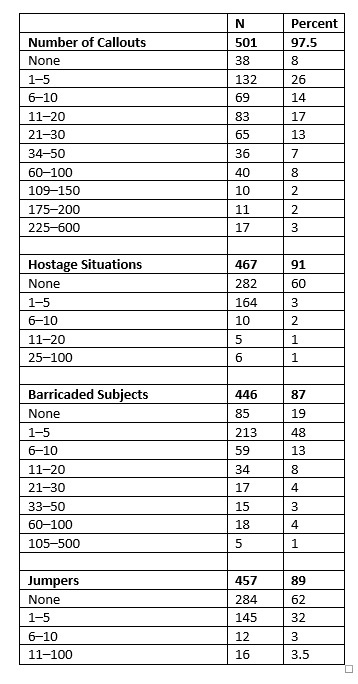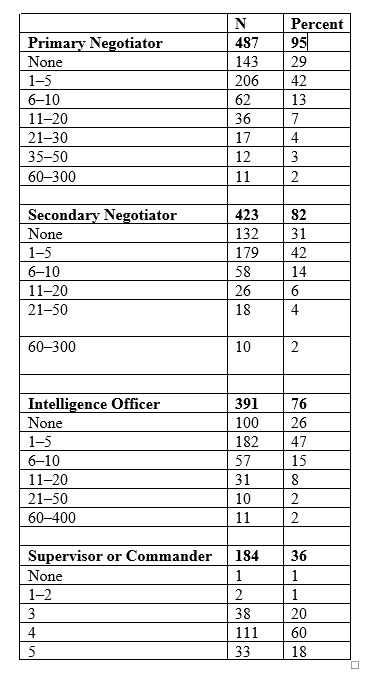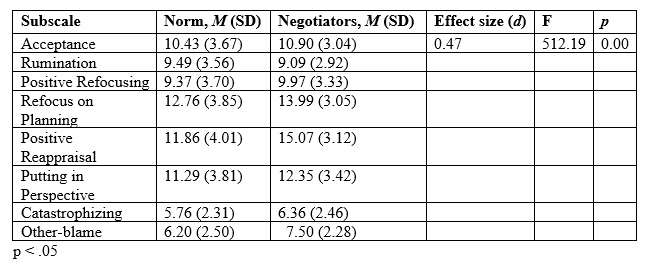Hostage (crisis) negotiators, perform vital duties under the most stressful of circumstances, yet little research has been conducted about the individuals who choose this work.1 Negotiators most often function as one component of a SWAT team within a police department, sheriff’s office, state patrol, federal agency, or other law enforcement entity, though there are times negotiating teams are callout out separately (e.g. in the case of someone threatening to jump from a high place). SWAT Negotiating teams are typically deployed on high-risk warrant service operations and in other situations too difficult, complicated, or dangerous for a contingent of patrol officers. Examples of these dangerous situations include, but are not limited to, hostage situations, barricaded subjects, suicidal subjects, and situations in which someone is actively harming or shooting other people (“active shooters”). These specially trained teams are typically deployed to contain and respond with the appropriate force and tactics necessary to protect lives.
In light of the extreme circumstances and delicate nature of being a police hostage negotiator, knowing as much as possible about the men and women doing this work could prove beneficial for the ongoing training and future selection of negotiators. Many researchers have studied the notion of a police personality and its applications, and some have studied the skills and knowledge needed to be a negotiator or made reference to the qualities that might make a good negotiator, but few studies have examined the callout experiences of negotiators or the personality, coping, and decision-making skills of active negotiators.2
The current study sought to learn more about the number and types of calls responded to by active police hostage negotiators. It also sought to learn more about the typical age, gender, marital status, ethnicity, rank, years of experience as a police officer, years of experience as a negotiator, and the typical duties performed on a call by a police hostage negotiator.
Along with these demographic and descriptive questions, the current study sought to understand and clearly define the personality profile of the typical police hostage negotiator and to understand the cognitive-emotional coping styles and decision-making styles that may be common among hostage negotiators. The current study endeavored to employ the recommendations of forensic psychologists Amy Grubb and Sarah Brown in an effort to provide empirical research on police hostage negotiators.3 The current study also hoped to identify the experiences or personal characteristics of negotiators that might be necessary for being an effective police hostage negotiator.
Survey Participants
Of the 147 agencies and negotiator associations that agreed to participate, 119 (81 percent) in 38 states returned 514 completed surveys. The rank of respondents ranged from officer or deputy to chief and averaged somewhere between that of a corporal and sergeant. Other ranks reported were detective, K-9 officer, ranger, special agent, trooper pilot, county attorney officer, technical sergeant, communications supervisor, and community service officer.
In addition to rank, the survey requested other demographics such as gender, race, and marital status.
- 78 percent of respondents were male.
- 76.5 percent of respondents were married.
- Respondents ranged in age from 23 to 64 years.
- 74 percent of respondents were white, 10 percent were Hispanic, 9.2 percent were black, 1.8 percent were Asian, and 1 percent were Native American, with 4 percent identifying as other ethnicities.
- Respondents’ years of experience in law enforcement was between 2 and 50 years; the range of experience as crisis negotiators was from newly-trained to 29 years.
Data about the agencies for which the respondents worked were also collected.
- Departments ranged in size from 6 to 5,000 employees.
- 68 percent of the respondents worked in a city police department, 19 percent worked for a sheriff’s office, 9 percent worked for a state patrol agency, and 4 percent worked for a “unified” department, with a few indicating employment by other types of agencies.
- Of the 119 departments, 78 indicated the size of their negotiating team with an average team size of 13 members (ranged from 1 to 46 members).
- 501 negotiators responded to 18,536 callouts in total, with 85 percent involved in 50 callouts or less (ranged from 0 to 600 callouts).
Table 1 provides information about the number and types of callouts responded to by the negotiators surveyed, and how many times a negotiator responded to each type of callout. Calls involving barricaded subjects are most common for these respondents.

Table 2 provides information about negotiator roles during callouts.

Three hundred and eighty-four negotiators answered the question, “How well are you prepared for the next hostage situation?” A Likert scale from zero (Poorly) to five (Outstanding) was provided. The mean answer for this question was 3.96 (SD = .71), indicating most negotiators feel well-prepared for the next hostage situation.
Results Summary
Experience
The variable type of agency for which a negotiator worked (e.g., police department, sheriff’s office) correlated (p < .05) with the number of callouts to which negotiators responded. It seems city police departments are more likely than sheriff’s offices or state patrols to utilize negotiators on callouts.
The size of the department correlated (p < .01) with the number of callouts negotiators responded to, the number of callouts in which a negotiator served as the primary negotiator, and the number of callouts involving a hostage situation. This indicates that larger departments have had more callouts, more hostage situations to which they have responded and thus gives negotiators more experience.
The majority of the negotiators surveyed (70 percent) responded to 30 callouts or less, and only 39 percent of the negotiators in this survey have responded to a hostage situation, with a similar number (38.5 percent) with experience responding to a jumper situation. Barricaded subject callouts are most common; 61 percent of the surveyed negotiators have responded to at least 10 barricaded subject callouts.
The number of callouts the negotiators in this sample responded to correlated (p < .01) with the number of callouts in which the negotiator served as the primary negotiator and the number of callouts involving hostages. This may indicate more experienced negotiators are more likely to be the primary negotiator on these types of callouts.
As indicated by these findings, training time should be spent on all the roles of negotiator, including being the secondary negotiator, intelligence officer, and in dealing with barricaded or suicidal subjects, including jumper situations, which are a special type of suicidal subject situation and require tactical consideration and preparation (e.g., how to approach and contain a jumper depending on the location or how to safely anchor negotiators). For training and selection purposes, it may be worthwhile to consider that one-third of this sample has yet to perform as the primary negotiator.
Police Negotiator Traits and Coping Skills
The Big 5 personality test scores for this sample yielded interesting results when means were compared with those of the general population.4 Negotiators in this sample scored lower on the Conscientiousness, Agreeableness, Extroversion, and Neuroticism scales, and had higher scores on the Openness scale. These results indicate the personality profile of a typical police negotiator.
The number of years of experience in law enforcement negatively correlated (p < .05) with the Big 5 personality trait of Openness, which indicates that the longer one is in law enforcement, the less one will prefer or seek novelty and change, and experiment with new or uncertain experiences.
The Cognitive Emotion Regulation Questionnaire (CERQ) scores for this sample also yielded interesting results when the means were compared with those of the general population.5 Negotiators in this sample had scores significantly lower on the Rumination scales and significantly higher on the Acceptance, Positive Refocusing, Refocus on Planning, Positive Reappraisal, Putting into Perspective, Catastrophizing, and Other-blame scales. It is good to know the negotiators in this sample are not preoccupied with thoughts associated with a negative event (Rumination), especially in light of their above average exposure to negative and traumatic events. It is also good to know the negotiators in this sample are able to accept what happens (Acceptance), are able to think about the pleasant things associated with an event (Positive Refocusing), are able to think about a plan to change a situation or think about steps to deal with a situation (Refocus on Planning), are able to attribute positive meaning to an event (Positive Reappraisal), and are able to play down the severity of an event by comparing it with other events (Putting into Perspective). All of these coping strategies are adaptive and are qualities to be looked for in prospective negotiators. It may also be helpful to discuss these coping strategies in the ongoing training of negotiators.

The number of years of experience correlated negatively (p < .01) with the CERQ personality style of Self-blame, indicating that the longer one is in law enforcement, the less one will hold oneself responsible for his or her own mistakes and feel guilty or feel responsible for causing an experience. Similarly, years of experience correlated negatively (p < .01) with the CERQ personality style of Rumination, indicating that the longer one is in law enforcement, the less one will preoccupy themselves with thoughts or feelings associated with a negative event. And, lastly, years of experience correlated negatively (p < .01) with Positive Reappraisal, indicating that the longer one is in law enforcement, the less one will attribute positive meaning to an event or believe positive growth can come from an event.
Negotiators in this sample also had significantly higher scores on the Catastrophizing and Other-blame scales. It may be helpful to discuss in training the drawbacks of focusing on how terrible an event was (Catastrophizing), and how to focus on the other coping strategies that seem to come easily to police negotiators. At first look, the elevated Other-blame scores may indicate a maladaptive coping strategy that is commonly employed by negotiators. However, in light of the types of callouts in which negotiators are called upon to intervene, it seems rational negotiators would blame others for the outcome of a situation because the subjects in those situations ultimately have that power and responsibility (e.g., a barricaded hostage taker deciding to kill his hostage and then kill himself).
Decision-Making Styles
The variable type of agency worked for correlated (p < .05) with an Intuitive decision-making style, which is quick, based on limited information, and subject to change as more information is presented.6 The results indicated that city police departments might have a specific culture that lends itself to this type of decision-making, which lends itself to relying on hunches, feelings, or intuition in decision-making.
The size of the department also correlated (p < .01) with a Rational decision-making style, which is typically fact-based, considers the long-term, and involves a thorough search for and evaluation of alternatives.7 This result indicates that large departments might require negotiators to employ a Rational decision-making style. Years of experience as a negotiator also correlated (p < .05) with a Rational decision-making style.
Finally, the number of callouts in which a negotiator served as the primary negotiator correlated (p < .05) with a Dependent decision-making style (looking to others when making a decision).8 Negotiators with a lot of callout experience appear to employ a decision-making style that is more team-oriented and looks for advice, support, and direction from others.
It seems fair to conclude negotiators who have a number of years of experience and callout experience use a Rational and/or Dependent decision-making style. These would be traits to look for in prospective negotiators. (e.g., Can a negotiator applicant thoroughly search for alternatives, logically evaluate those alternatives, and work with a team in making a decision?) There also seems to be a place in police negotiations for a decision-making style that relies on hunches and intuition, and this type of decision-making should also be considered in negotiator applicant selection.9
The female negotiators in this study most often worked for a city police department, had fewer years of experience in law enforcement than their male peers, and did not employ a Rational decision-making style. Negotiators from city police departments often used an Intuitive decision-making style, and this may be a common decision-making style among female police officers. In summary, it may be beneficial to look for a Rational, a Dependent, and an Intuitive decision-making style when interviewing officers for membership on negotiating teams.
When it comes to the demanding, high-stress work of being a hostage negotiator, the personality, coping styles and decision-making styles of a negotiator may prove to be vitally important for the health and longevity of all involved in a callout situation. Care and attention, both in the selection and the training of negotiators must be a core component, and may be enhanced by the application of the information obtained through this study and the use of a combination of these measures for obtaining a total understanding about a potential hostage negotiator during an interview process.
Notes:
1 See Andrew Young, Fight or Flight: Negotiating Crisis on the Front Line (Chambersburg, PA: eGen Publishing, 2015); Amy R. Grubb, Sarah J. Brown, and Peter Hall, “Personality Traits and Coping Styles in UK Police Officers: Do Negotiators Differ from Their Non-Negotiator Colleagues?” Psychology, Crime and Law 21, no. 4 (2015): 347–374.
2 For examples, see Jonathan Black, “Personality Testing and Police Selection: Utility of the ‘Big Five,’ New Zealand Journal of Psychology 29 (2000): 2–9; Paul Detrick, John T. Chibnall, and Michael C. Luebbert, “The Revised NEO Personality Inventory as Predictor of Police Academy Performance,” Criminal Justice and Behavior 31, no. 6 (December 2004): 676–694; James L. Greenstone, “The Twenty-Five Most Serious Errors Made by Police Hostage and Crisis Negotiators,” Journal of Police Crisis Negotiations 7, no. 2 (2007): 107–116; Michael J. McMains and Wayman C. Mullins, Crisis Negotiations: Managing Critical Incidents and Hostage Situations in Law Enforcement and Corrections (New York, NY: Taylor & Francis, 2014); Chuck Regini, “Crisis Negotiation Teams,” FBI Law Enforcement Bulletin 71, no. 11 (November 2002): 1–5.
3 Amy R. Grubb and Sarah J. Brown, “Hostage (Crisis) Negotiation: The Potential Role of Negotiator Personality, Decision-Making Style, Coping Style and Emotional Intelligence on Negotiator Success,” International Journal of Emergency Mental Health 14, no. 1 (November 2012): 41–55.
4 Oliver P. John and Sanjay Srivastava, “The Big-Five Trait Taxonomy: History, Measurement, and Theoretical Perspectives,” in Handbook of Personality: Theory and Research, vol. 2, eds. Lawrence A. Pervin and Oliver P. John (New York, NY: Guilford Press, 1999).
5 Nadia Garnefski, Vivian Kraaij, and Philip Spinhoven, Manual for the Use of the Cognitive-Emotion Regulation Questionnaire (Leiderdorp, The Netherlands: 2002).
6 Susanne G. Scott and Reginald A. Bruce, “Decision-Making Style: The Development and Assessment of a New Measure,” Educational and Psychological Measurement 55, no. 5 (October 1995): 818–831.
7 Ibid.
8 Ibid.
9 For an interesting examination of intuition, see Jonah Lehrer, How We Decide (New York, NY: Mariner Books, 2009).



